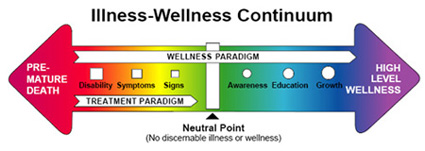Today, there is an increasingly urgent need for individuals
to a take a greater level of responsibility for their health and well-being. Spiraling healthcare costs have made it nearly impossible for an average family to pay for basic healthcare. Companies are struggling to pay their employees’ health benefits, and the federal government has no answers. We are on our own.
And we can’t look to help from our doctor. Over 2000 years
ago Hippocrates, the father of western medicine, stated that the primary role of the physician is educator, but health professionals in the fast-paced 21st century have no time to devote to educating their patients on how to live a healthy lifestyle.
At the same time, today there is a parallel trend of people
looking for more personalized approaches to wellness. People want to go beyond the cold, by-the-numbers approaches of conventional medicine and be viewed as a “whole person” — addressing the physical, emotional, mental, and spiritual dimensions of our lives.
These two trends are nothing new as they represent two
of the key principles—“Self-Responsibility” and “Treating
the Whole Person”—that were hallmarks of the wellness and
holistic health movements of the 1970s. A quarter-century later,
these principles, once dismissed by conventional healthcare
as being too progressive, are now being viewed as essential
core elements to solving the current healthcare crisis.
Teaching People to Be Well
Over thirty years ago a young resident at Johns Hopkins had
a flash of inspiration that would come to have a major impact
on these two challenges facing us today. This young doctor,
John W. Travis, MD, MPH, had been working in the U.S. Public
Health Service where he was a protégé of Dr. Lewis Robbins,
the creator of the Health Risk Appraisal (HRA). He had also
been influenced by Dr. Abraham Maslow’s concept of self-actualization.
Late one night in his office he envisioned the idea for
the Illness-Wellness Continuum (see below), that placed
“wellness” in a revolutionary new context which bridged health
and human potential.
Dr. Travis decided to dedicate his life to “teaching people to
be well,” rather than treating patients, and so he subsequently
left for California where he helped to pioneer the modern wellness
movement—opening the first wellness center in America
in 1975, writing the classic Wellness Workbook, and creating the
first wellness assessment, the Wellness Inventory, to serve the
needs of his new wellness-oriented clients.
However, most pioneers are ahead of their time, and by
the 1980s the wellness concept was catching on in corporate
America and moving farther and farther away from a whole person
focus. Then, wellness was associated with weight loss,
stress reduction, and smoking cessation programs as well as
medical screenings and health risk appraisals. This continued
for 25 years until the current health care crisis forced consumers,
corporate executives, the health care industry, and the
Federal government to look for new and innovative solutions.
Dr. Travis’ original Illness-Wellness Continuum, developed originally
in 1972, has been widely reprinted in health and medical
textbooks worldwide for over 30 years.

The continuum shows the relationship of the Wellness and Treatment Paradigms.
Moving from the center to the left shows a deteriorating state
of health. Moving to the right of center indicates increasing
levels of health and well-being. The Treatment Paradigm can
only take you to the neutral point, where the symptoms of disease
have been alleviated. That is all it is designed to do. The
Wellness Paradigm, on the other hand, which can be utilized
at any point on the continuum, helps you move toward higher
levels of wellness.